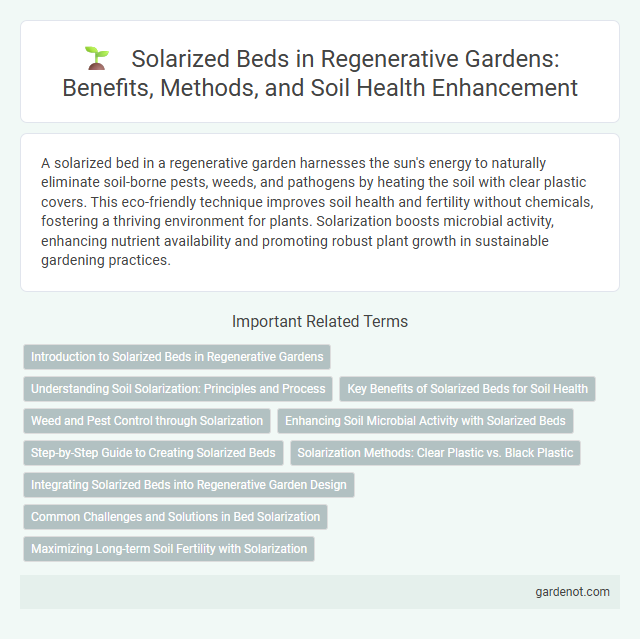A solarized bed in a regenerative garden harnesses the sun's energy to naturally eliminate soil-borne pests, weeds, and pathogens by heating the soil with clear plastic covers. This eco-friendly technique improves soil health and fertility without chemicals, fostering a thriving environment for plants. Solarization boosts microbial activity, enhancing nutrient availability and promoting robust plant growth in sustainable gardening practices.
Introduction to Solarized Beds in Regenerative Gardens
Solarized beds utilize solar energy to naturally sanitize soil by harnessing the heat generated under clear plastic covers, effectively reducing pathogens and weeds without chemicals. This regenerative gardening technique enhances soil health, stimulating beneficial microbial activity and promoting nutrient availability for plants. Integrating solarized beds supports sustainable agriculture by improving crop resilience and productivity while minimizing environmental impact.
Understanding Soil Solarization: Principles and Process
Soil solarization is an eco-friendly technique that uses solar energy to heat the soil, eliminating pathogens, weeds, and pests while enhancing soil fertility for regenerative gardens. By covering moist soil with transparent polyethylene sheets during the hottest months, temperatures reach levels that disrupt harmful organisms without chemicals. This process improves soil structure and promotes beneficial microbial activity, supporting sustainable plant growth.
Key Benefits of Solarized Beds for Soil Health
Solarized beds harness solar energy to elevate soil temperatures, effectively eliminating pathogens, weed seeds, and pests without chemical use. This process enhances nutrient availability, boosts microbial activity, and improves soil structure, leading to healthier plant growth. Solarization also increases organic matter decomposition rates, promoting sustainable soil fertility in regenerative gardening.
Weed and Pest Control through Solarization
Solarized beds utilize solarization, a weed and pest control method that harnesses solar heat to sterilize the soil, effectively reducing weed seeds, fungal pathogens, and soil-borne pests without chemical intervention. This technique involves covering moist soil with clear plastic sheeting during hot seasons, raising soil temperatures to 45-60degC (113-140degF), which disrupts pest life cycles and inhibits weed germination. Solarization enhances soil health by preserving beneficial microorganisms, promoting a balanced ecosystem in regenerative garden practices.
Enhancing Soil Microbial Activity with Solarized Beds
Solarized beds increase soil temperature by trapping solar energy, which accelerates microbial activity essential for nutrient cycling and organic matter decomposition. This process suppresses harmful pathogens and pests while promoting beneficial microorganisms that improve soil structure and fertility. Enhanced microbial diversity in solarized beds supports regenerative garden health by boosting plant growth and resilience naturally.
Step-by-Step Guide to Creating Solarized Beds
Solarized beds optimize soil health by using solar energy to eliminate pathogens and weeds through plastic-covered heating. Begin by moistening the soil, then cover it tightly with transparent plastic sheeting during the hottest months, typically 4 to 6 weeks of direct sunlight exposure. After solarization, aerate the soil and incorporate organic matter to maximize nutrient availability and promote regenerative growth.
Solarization Methods: Clear Plastic vs. Black Plastic
Solarized beds utilize solarization methods by covering soil with clear plastic or black plastic to harness solar energy for weed suppression and soil pathogen reduction. Clear plastic solarization increases soil temperature more effectively by allowing sunlight to penetrate and trap heat, reaching up to 50-60degC, while black plastic absorbs heat but limits sunlight, primarily warming the soil surface. Choosing between clear and black plastic depends on factors like desired temperature, soil type, and pest control goals within regenerative gardening practices.
Integrating Solarized Beds into Regenerative Garden Design
Integrating solarized beds into regenerative garden design accelerates soil restoration by using solar heat to naturally eliminate pathogens, weeds, and pests. This method enhances soil fertility and structure, promoting beneficial microbial activity and improving nutrient cycling within the garden ecosystem. Solarized beds complement cover cropping and composting practices, creating a holistic approach to sustainable and resilient garden management.
Common Challenges and Solutions in Bed Solarization
Soil solarization often faces challenges such as uneven heat distribution and moisture loss, which can reduce its effectiveness in controlling soil-borne pests and weeds. Ensuring a consistently moist soil surface before covering with clear plastic improves heat conduction, while securing edges tightly prevents heat escape and maintains optimal temperature. Adjusting solarization duration based on local climate and sun exposure further enhances pest control and soil health in regenerative gardens.
Maximizing Long-term Soil Fertility with Solarization
Solarized beds utilize solar heat to sterilize soil, effectively reducing pathogens, weed seeds, and pests while preserving beneficial microorganisms critical for soil health. The process involves covering moist soil with clear plastic during peak sunlight periods, raising temperatures high enough to break down organic matter and enhance nutrient availability. This method promotes long-term soil fertility by improving microbial activity and nutrient cycling, essential for sustainable regenerative gardening practices.
Solarized bed Infographic

 gardenot.com
gardenot.com